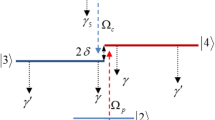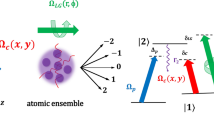Abstract
We conduct theoretical and numerical studies of the performance of a 2D electromagnetically induced grating in a 4-level quantum system, which is situated near a plasmonic nanostucture. The plasmonic nanostructure is built by metal-coated dielectric nanospheres in a periodic 2D arrangement. The double V-type system is coupled by a weak probe laser, a spatially-dependent standing wave field and a Laguerre–Gaussian field. The plasmonic metamaterial causes quantum interference in the spontaneous emission from the two closely situated upper states, which makes the amplitude and phase modulations of the weak probe light dependent on the azimuthal angle and the orbital angular momentum of the vortex coupling beam. In the absence of the plasmonic nanostructure this behavior does not exist due to the lack of quantum interference. We demonstrate that by adjusting the parameters of the vortex beam, as well as the distance to the plasmonic nanostructure, the amplitude and phase modulations of the probe laser, and the Fraunhofer diffraction patterns of the grating can be controlled, directing the weak probe light energy to high-orders. The spatially dependent coupling light causes the Fraunhofer diffraction to have an asymmetric patterns when a negative or a positive value of the winding number is applied. Our work proposes a straightforward scheme for manipulation of the diffraction efficiency of the grating by utilizing both the winding number of the Laguerre–Gaussian beam, and the distance between the quantum system and the plasmonic nanostructure as control knobs.







Similar content being viewed by others
Data Availability Statement
This manuscript has associated data in a data repository. [Authors’ comment: All data included in this manuscript are available upon request by contacting the corresponding author.]
References
H.A. Atwater, A. Polman, Plasmonics for improved photovoltaic devices. Nat. Mater. 9, 205–213 (2010)
M.W. Knight, H. Sobhani, P. Nordlander, N.J. Halas, Photodetection with active optical antennas. Science 332(6030), 702–704 (2011)
N. Liu, M.L. Tang, M. Hentschel, H. Giessen, A.P. Alivisatos, Nanoantenna-enhanced gas sensing in a single tailored nanofocus. Nat. Mater. 10, 631–636 (2011)
D. Boyer, P. Tamarat, A. Maali, B. Lounis, M. Orrit, Photothermal imaging of nanometer-sized metal particles among scatterers. Science 297(5584), 1160–1163 (2002)
K.A. Willets, R.P. Van Duyne, Localized surface plasmon resonance spectroscopy and sensing. Ann. Rev. Phys. Chem. 58, 267–297 (2007)
E.R. Corson, E.B. Creel, R. Kostecki, B.D. McCloskey, J.J. Urban, Important considerations in plasmon-anhanced electrochemical conversion at voltage-biased electrodes. iScience, 23, 100911-1–100911-10 (2020)
W. Ou, B. Zhou, J. Shen, Ch. Zhao, Y.Y. Li, J. Lu, Plasmonic metal nanostructures: concepts, challenges and opportunities in photo-mediated chemical transformations. iScience 24, 101982-1–101982-17 (2021)
S. Evangelou, V. Yannopapas, E. Paspalakis, Transparency and slow light in a four-level quantum system near a plasmonic nanostructure. Phys. Rev. A 86, 053811-1–053811-9 (2012)
L. Wang, Y. Gu, H. Chen, J.-Y. Zhang, Y. Cui, B.D. Gerardot, Q. Gong, Polarized linewidth-controllable double-trap** electromagnetically induced transparency spectra in a resonant plasmon nanocavity. Sci. Rep. 3, 2879-1–2879-7 (2013)
J.D. Cox, M.R. Singh, C. von Bilderling, A.V. Bragas, A nonlinear switching mechanism in quantum dot and metallic nanoparticle hybrid systems. Adv. Opt. Mater. 1(6), 460–467 (2013)
M.R. Singh, Enhancement of the second-harmonic generation in a quantum dot-metallic nanoparticle hybrid system. Nanotechnology 24(12), 125701 (2013)
M.A. Antón, F. Carreño, S. Melle, O.G. Calderón, E. Cabrera-Granado, M.R. Singh, Optical pum** of a single hole spin in a p-doped quantum dot coupled to a metallic nanoparticle. Phys. Rev. B 87, 195303-1–195303-13 (2013)
E. Paspalakis, S. Evangelou, A.F. Terzis, Control of excitonic population inversion in a coupled semiconductor quantum dot-metal nanoparticle system. Phys. Rev. B 87, 235302-1–235302-6 (2013)
E. Paspalakis, S. Evangelou, V. Yannopapas, A.F. Terzis, Phase-dependent optical effects in a four-level quantum system near a plasmonic nanostructure. Phys. Rev. A 88, 053832-1–0538322-8 (2013)
D. Bortman-Arbiv, A.D. Wilson-Gordon, H. Friedmann, Phase control of group velocity: from subluminal to superluminal light propagation. Phys. Rev. A 63, 043818-1–0438182-7 (2001)
J.-H. Wu, J.-Y. Ga, Phase control of light amplification without inversion in a \(\Lambda\) system with spontaneously generated coherence. Phys. Rev. A 65, 063807-1–063807-5 (2002)
W.-H. Xu, J.-H. Wu, J.-Y. Gao, Effects of spontaneously generated coherence on transient process in a \(\Lambda\) system. Phys. Rev. A 66, 063812-1–063812-6 (2002)
H.-Y. Ling, Y.-Q. Li, M. **ao, Electromagnetically induced grating: homogeneously broadened medium. Phys. Rev. A 57(2), 1338–1344 (1998)
M. Mitsunaga, N. Imoto, Observation of an electromagnetically induced grating in cold sodium atoms. Phys. Rev. A 59(6), 4773–4776 (1999)
G.C. Cardoso, J.W.R. Tabosa, Electromagnetically induced gratings in a degenerate open two-level system. Phys. Rev. A 65, 033803-1–033803-7 (2002)
S.E. Harris, J.E. Field, A. Imamoĝlu, Nonlinear optical processes using electromagnetically induced transparency. Phys. Rev. Lett. 64(10), 1107–1110 (1990)
M. Fleischhauer, A. Imamoĝlu, J.P. Marangos, Electromagnetically induced transparency. Rev. Mod. Phys. 77, 633–637 (2005)
D. Moretti, D. Felinto, J. Tabosa, A. Lezama, Dynamics of a stored Zeeman coherence grating in an external magnetic field. J. Phys. B At., Mol. Opt. Phys. 43, 115502-1–115502-7 (2010)
A.W. Brown, M. **ao, All-optical switching and routing based on an electromagnetically induced absorption grating. Opt. Lett. 30(7), 699–701 (2005)
L. Zhao, W. Duan, S.F. Yelin, All-optical beam control with high speed using image-induced blazed gratings in coherent media. Phys. Rev. A 82, 013809-1–013809-8 (2010)
P.W. Zhai, X.M. Su, J.Y. Gao, Optical bistability in electromagnetically induced grating. Phys. Lett. A 289, 27–33 (2001)
F. Wen, W. Wang, I. Ahmed, H. Wang, Y. Zhang, Y. Zhang, A.R. Mahesar, M. **ao, Two-dimensional Talbot self-imaging via electromagnetically induced lattice. Sci. Rep. 7, 41790-1–41790-9 (2017)
Y. Zhang, Ch. Yuan, Y. Zhang, H. Zheng, H. Chen, Ch. Li, Zh. Wang, M. **ao, Surface solitons of four-wave mixing in an electromagnetically induced lattice. Laser Phys. Lett. 10, 055406-1–055406-5 (2013)
S. Franke-Arnold, J. Leach, M.J. Padgett, V.E. Lembessis, D. Ellinas, A.J. Wright, J.M. Girkin, P. Öhberg, A.S. Arnold, Optical ferris wheel for ultracold atoms. Opt. Express 15(14), 8619–8625 (2007)
X. He, P. Xu, J. Wang, M. Zhan, Rotating single atoms in a ring lattice generated by a spatial light modulator. Opt. Express 17(23), 21007–21014 (2009)
L. Wang, F. Zhou, P. Hu, Y. Niu, Sh. Gong, Two-dimensional electromagnetically induced cross-grating in a four-level tripod-type atomic system. J. Phys. B At. Mol. Opt. Phys. 47(22), 013838-1–013838-7 (2014)
T. Naseri, R. Sadighi-Bonabi, Electromagnetically induced phase grating via population trap** condition in a microwave-driven four-level atomic system. J. Opt. Soc. Am. B 31, 2879–2884 (2014)
S.H. Asadpour, H.R. Hamedi, T. Kirova, E. Paspalakis, Two-dimensional electromagnetically induced phase grating via composite vortex light. Phys. Rev. A 105, 043709-1–043709-11 (2022)
D.L. Andrews, M. Babiker, The Angular Momentum of Light (Cambridge University Press, Cambridge, 2012)
G. Molina-Terriza, J.P. Torres, L. Torner, Twisted photons. Nat. Phys. 3, 305–310 (2007)
J. Wang, Advances in communications using optical vortices. Photon. Res. 5, B14–B28 (2016)
H.R. Hamedi, J. Ruseckas, E.Paspalakis, G. Juzeliūnas, Transfer of optical vortices in coherently prepared media. Phys. Rev. A 99(3), 053822-1–053822-5 (2019)
H.R. Hamedi, E. Paspalakis, G. Zlabys, G. Juzeliūnas, J. Ruseckas, Complete energy conversion between light beams carrying orbital angular momentum using coherent population trap** for a coherently driven double-Lambda atom-light-coupling scheme. Phys. Rev. A 100, 023811-1–023811-8 (2019)
Z. Dutton, J. Ruostekoski, Transfer and storage of vortex States in light and matter waves. Phys. Rev. Lett. 93, 193602-1–193602-4 (2004)
J. Ruseckas, G. Juzeliūnas, P. Öhberg, Polarization rotation of slow light with orbital angular momentum in ultracoldatomic gases. Phys. Rev. A 76, 053822-1–053822-5 (2007)
S.H. Asadpour, A. Panahpour, M. Jafari, Phase-dependent electromagnetically induced grating in a four-level quantum system near a plasmonic nanostructure. Eur. Phys. J. Plus, 133, 411-1–411-7 (2018)
H.R. Hamedi, V. Yannopapas, E. Paspalakis, Spatially structured optical effects in a four-Level quantum system near a plasmonic nanostructure. Ann. Phys. 533, 2100117 (2021)
V. Yannopapas, E. Paspalakis, N.V. Vitanov, Plasmon-induced enhancement of quantum interference near metallic nanostructures. Phys. Rev. Lett. 103, 063602-1–063602-4 (2009)
S. Evangelou, V. Yannopapas, E. Paspalakis, Modifying free-space spontaneous emission near a plasmonic nanostructure. Phys. Rev. A 83, 023819-1–023819-7 (2011)
S. Evangelou, V. Yannopapas, E. Paspalakis, Simulating quantum interference in spontaneous decay near plasmonic nanostructures: population dynamics. Phys. Rev. A 83, 055805-1–0558059-4 (2011)
H. Yan, K.-Y. Liao, J.-F. Li, Y.-X. Du, Zh.-M. Zhang, Sh.-L. Zhu, Bichromatic electromagnetically induced transparency in hot atomic vapors. Phys. Rev. A 87, 055401-1–055401-5 (2013)
S.H. Asadpour, T. Kirova, J. Qia, H.R. Hamedi, G. Juzeliūnas, E. Paspalakis, Azimuthal modulation of electromagnetically induced grating using structured light. Sci. Rep. 11, 20721-1–20721-11 (2021)
Y. Gu, L. Wang, P. Ren, J.-X. Zhang, T.-C. Zhang, O.J.F. Martin, Q.-H. Gong, Surface-plasmon-induced modification on the spontaneous emission spectrum via subwavelength-confined anisotropic purcell factor. Nano Lett. 12, 2488–2493 (2012)
M. Sukharev, S.A. Malinovskaya, Stimulated Raman adiabatic passage as a route to achieving optical control in plasmonics. Phys. Rev. A 86, 043406-1–043406-7 (2012)
A.A. Hashim, Polymer Thin Films (IntechOpen, London, 2010)
Funding
This work was supported by a STSM Grant from COST Action CA16221 for T. Kirova and H. R. Hamedi. T. Kirova received support from the Grant No. LV-LT-TW/2022/4 “Coherent Optical Control of Atomic Systems” by the Ministry of Education and Science of the Republic of Latvia. H. R. Hamedi acknowledges support from the Grant No. S-LLT-22-2 “Coherent Optical Control of Atomic Systems” by the Lithuanian Council of Research.
Author information
Authors and Affiliations
Contributions
EP and HRH generated the idea and designed the theoretical methods. SHA performed the numerical investigations. The results were interpreted by VY and EP. TK prepared the manuscript for publication. All authors contributed to editing the manuscript.
Corresponding author
Ethics declarations
Conflict of interest
The authors declare that they have no conflict of interest.
Rights and permissions
Springer Nature or its licensor (e.g. a society or other partner) holds exclusive rights to this article under a publishing agreement with the author(s) or other rightsholder(s); author self-archiving of the accepted manuscript version of this article is solely governed by the terms of such publishing agreement and applicable law.
About this article
Cite this article
Asadpour, S.H., Kirova, T., Hamedi, H.R. et al. Azimuthal dependence of electromagnetically induced grating in a double V-type atomic system near a plasmonic nanostructure. Eur. Phys. J. Plus 138, 246 (2023). https://doi.org/10.1140/epjp/s13360-023-03871-z
Received:
Accepted:
Published:
DOI: https://doi.org/10.1140/epjp/s13360-023-03871-z




